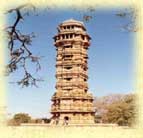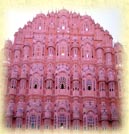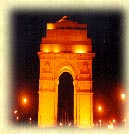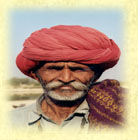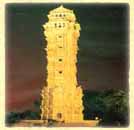|
Day 01: Arrival in
New Delhi
Around midnight arrive in
New Delhi. The cosmopolitan City and capital New Delhi is the main gateway for travelers. Upon arrival, you will be met by an Indo Vacations representative and transferred to the Hotel.
Day 02: New Delhi
In the morning we have sightseeing in Old Delhi. We take a Rickshaw Ride
parallel to the
Red Fort through the old city and famous Silk Road and Silver Bazaar. Sightseeing of Old Delhi includes "Rajghat", the site where
Mahatma Gandhi was cremated and
Jama Masjid, the great mosque of old Delhi. Today we also visit the famous "Humayun Tomb" which is the first substantial example of Mughal
architecture in
India and "Qutub Minar".
"Qutub Minar" is 71 meter high and consists of five stories. In 1199 work began on this tower which was intended to be the most glorious tower of victory in the world. This tower was damaged twice and repaired in 1326 and 1368. Before we proceed to the Hotel we drive through the embassy area in New Delhi where we visit the
India Gate and see some impressive Government Buildings.
Day 03: New Delhi - Alwar (about 170 km / 3˝ hours)
In the morning we drive to
Alwar. Alwar is referred as the gateway to the historic and colorful state of Rajasthan. Alwar has had a chequered history and has been a witness to many rules and rulers. It offers the traveler various sites of historical importance. The main tourist attraction of Alwar is City Palace or Vinay Vilas Mahal. In the afternoon we visit the
Vinay Vilas Mahal or
City Palace. This palace has a fine museum with more than 7000 manuscripts, miniature paintings in both Mughal and Rajasthani style, armour, textiles and musical instruments. In the evening we will visit the
Siliserh Lake.
Day
04: Alwar - Jaipur (about 148 km / 3 hours)
Today we leave Alwar and drive to the Pink City
Jaipur. This city owes its name,
foundations and careful planning to the great warrior and astronomer, Maharaja
Sawai Jai Singh II. Jaipur is the capital of Rajasthan and famous for its
handicrafts and precious and semiprecious stones. In the afternoon arrival in
Jaipur. The rest of the day at leisure.
Day 05: Jaipur
After breakfast we
drive to the ancient capital of
Amber, laying 11 km. away from Jaipur. Amber was the ancient capital of
Kachhawaha dynasty for 6 centuries before it was moved to newly created Jaipur.
We will ascend to the Palace Fortress on the back of an Elephant. Enroute to
Amber we will visit the
Hawa Mahal
(Palace of the Winds), built in 1799 AD, it contains 953 small casements with
each having its own balcony. The windows enabled cool air to circulate and the
ladies to watch processions below without being seen. In the afternoon we visit
the City Palace that is still the formal residence of the royal family, built in
a blend of the Rajasthani and Mughal architecture. In the museum of the
City Palace we visit the
private collection of the Jaipur Maharajas. We continue to
Jantar Mantar, a stone
observatory, and the largest of Jai Singh's five remarkable observatories. Its
complex instruments reveal us the secrets of medieval Indian astronomy. Later we
have a walk through the colourful Bazaar of Jaipur and visit a factory to see
the famous block printing work being done since centuries in Jaipur. In the
evening we drive through the new city of Jaipur and visit "Laxmi Narayan Mandir",
a Hindu temple made out of white marble. We might have an opportunity here to
observe a prayer ceremony. Today we have dinner with a presentation of Indian
music and dance.
Day 06: Jaipur - Deeg - Bharatpur (about 200 km / 4 hours)
Today we leave Alwar and proceed to Bharatpur via Deeg.
Deeg, capital of the Jat rulers, came into existence in the 18th century. The credit for constructing the early palaces at Deeg goes to king Badan Singh. Deeg is known for its magnificent palaces constructed around the mid 18th century by Raja Suraj Mal, namely Suraj Bhawan, Gopal Bhawan and Kishan Bhawan. Gopal Bhawan, overlooking the Gopal Sagar is the most impressive of all the palaces. Gopal Bhawan with all its windows of stone lattice work, is flanked by two pavilions, Sawan and Bhadon with curved roofs and ornamental spires. To the north and south of the garden are Nand Bhawan and Krishna Bhawan respectively. Suraj Bhawan built in white marble, is an exquisite palace, with balconies overhanging the water. After visiting these palaces at Deeg we drive to
Bharatpur. In the evening arrive in Bharatpur.
Day 07: Bharatpur - Fatehpur Sikri - Agra (about 55 km / 1 hours)
In the morning we will visit the
Bharatpur
Bird Sanctuary or Keoladeo Ghana National Park. Bharatpur has its fame due to Keoladeo Birds National Park. Bharatpur was earlier a duck shooting resort of the Maharaja. The Bharatpur Bird Sanctuary with its 375 species is one of the best water bird sanctuary in the world. In winter there are many migratory birds from the northern hemisphere including the rare Siberian crane. After visiting the Bird Sanctuary we drive to
Agra. Enroute we make a stop and visit
Fatehpur Sikri, which was once an imperial capital frozen in time, constructed by Akbar the Great in the 16th century. This wonderful city constructed by red sand stones was abandoned as abruptly as it had been built. It has been generally stated that it was due to failing in the water supply. In the evening arrive in
Agra. Rest of the day at leisure.
Day 08: Agra - Dholpur (about 56 km / 1 hour)
We start today our sightseeing by a visit to the
Agra Fort, built by three of the greatest Mughal emperors. The construction of this massive structure began in 1565 under Akbar's reign and continued till the time of his grandson's reign, Shah Jahan who built the impressive imperial quarters and mosque. After the visit of Agra Fort we proceed to visit the most beautiful monument of India, the
Taj Mahal, an enduring monument to love, with a continually fulfilling beauty. It was built by the Mughal Emperor Shah Jahan between 1631-52, as a tomb and memorial to his beloved wife Mumtaz Mahal (Jewel of the Palace), who died at the age of 39 giving birth to her 14th child. After the visit of Taj Mahal we drive to Dholpur. Dholpur was founded in 1805. Dholpur is known for its locally-quarried sandstone.
Day 09: Dholpur - Ranthambore (about 216 km /
4˝ hours)
Today after the breakfast we visit the Jhor, a village 16 km from Dholpur. In Jhor, the oldest Mughal garden is situated. Started in 1527 by Babar, it was discovered in the late 1970s and there are still signs of the intricate planning that went into these gardens. The Mughal influence is very strong here in
Dholpur. There are various other places like Bari, Damoh waterfall, Talab-e Shahi lake, Kanpur Mahal, Van Vihar Wildlife Sanctuary and Ram Sagar Sanctuary in Dholpur which offer interesting excursions. Afterwards we drive to
Ranthambore. Ranthambore lies on the easternmost spur of the Aravalis. Ranthambore was the private tiger reserve of the Maharajas of Jaipur. It is studded with pavilions, watch towers. The town of Ranthambore is watched over by the massive Ranthambore fort. The main attractions of Ranthambore are the Ranthambore National Park and Ranthambore Fort.
Day 10: Ranthambore
In the early morning we will explore the
Ranthambore National Park and have a jungle safari. Ranthambore National Park is a well known tiger reserve under Project Tiger. Ranthambore National park is surrounded by the Vindhyas and the Aravali mountains and covers an area of 392 square km. The Tiger remains the biggest attraction of the Ranthambore National Park. This national park is the home of a vast variety of animals. Here we might have an audience with the tiger. In this park besides tiger various other animals like Sambhar, Cheetal, Wild Boar, Leopard, Sloth Bear, Jackal and Hyena can also be seen. In the afternoon we will visit Ranthambore Fort. This fort was built in 994 AD atop a steep high creek 200 metres above sea level. Ruined pavilions, walls, chhatris and splendid monuments are interspersed within the majestic fort. The Ranthambore fort also houses the temple of Lord Ganesha, where annual fair is held in the month of September on account of Ganesh Chaturthi.
Day 11: Ranthambore - Tonk - Bundi (about 125 km / 2˝ hours)
In the morning after having breakfast we drive to Bundi. Enroute we stop at
Tonk. Earlier Tonk was the stronghold of the Pathan tribesmen of Afghanistan who came to India. Tonk was founded by Nawab Ameer Khan as a result of a treaty with the British in 1818. Tonk is known for its famous Sunehri Kothi, the golden mansion and the Arabic and Persian Research Institute. In Tonk we visit the Sunehri Kothi and Research Institute. The Arabic and Persian Research Institute houses a superb collection of Arabic and Persian manuscripts. Some of these manuscripts are lavishly ornamented with gold, rubies, emeralds and pearls. In the evening arrive in
Bundi. Set in a narrow encircling gorge, the palaces and fortress of Bundi have a fairy tale like quality about them. Isolated and independent, the entire township appears like a miniature
painting, frozen in time for the traveler. Bundi is also known for its baolis or step-wells.
Day 12: Bundi - Jhalawar - Kota (about 38 km / 1 hour)
In the morning we visit the
Bundi palace. This palace built of locally quarried stone, presents one of the finest examples of Rajput architecture. Intricately carved brackets, pillars and balconies and sculpted elephants are used liberally. The Diwan-I-Aam, Hathi Pol and the Naubat Khana are the main places located inside the palace. The famous Chitra Shala which provides a colourful glimpse of history is also located inside the palace. The walls and ceilings of this palace are completely covered with paintings of the Bundi School. After visiting the Bundi palace we drive to Kota. Enroute we visit the town of Jhalawar. On the way to Jhalawar we come across the red poppy fields and the orange laden orchards. Jhalawar or the land of the 'Jhalas' was created in 1838 and has a charm of its own. Jhalawar district is known for the Chandrabhaga fair, celebrated every year in the month of Kartik (Oct-Nov) on the banks of the
Chandrabhaga River. The main area of interest in Jhalawar is the fort which is located in the centre of the town. This fort now houses various district offices. The Zanana Khas portion of the fort houses some exquisite paintings on walls and mirrors. After visiting the fort we move towards the town of
Kota. Earlier Kota was the part of the erstwhile
Rajput kingdom of Bundi.
Day 13: Kota - Bijolia - Chittorgarh (about 180
km / 4 hours)
In the morning in Kota we will visit the
Kota palace. This type of fort-palace complex is one of the largest to be found in the state of Rajasthan. Then we drive to Bijolia. In ancient times Bijolia was known as Vindhyavali. During the Chauhan period, it became a famous centre for art and
architecture. Several beautiful Shiva temples were constructed by the Chauhan rulers in Bijolia. On the eastern side of the town near the city wall, there are three beautiful temples. The most famous temple is the Hajaresvara Mahadeva temple. It has a high linga surrounded by hundreds of small lingas and hence called Hajaresvara or Sahastralinga. After visiting this temple and having lunch at Bijolia we drive to
Chittorgarh. Chittorgarh was founded by Bappa Rawal in 8th century. Chittorgarh is known for its massive fort which is 3 miles long and 495 feet high and also for Vijay Stambh (Tower of Victory) and Kirti Stambh.
Day 14: Chittorgarh - Dungarpur (about 200 km / 4 hours)
In the morning we visit the
Chittorgarh Fort, the world famous fort of Rajasthan. The Chittorgarh Fort is the indomitable pride of Chittor. The fort is massive structure with many gateways built in 7th century AD and perched on a height of 180 m hill and sprawls over 700 acres. After visiting the Chittorgarh fort we visit the
Vijay Stambh and Kirti Stambh. After having sightseeing in Chittorgarh we drive to Dungarpur. Dungarpur means a “Hill town”. Dungarpur was founded in 1358 A.D by Rana Dungar Singh. Dungarpur is a picturesque town surrounded by hills on three sides. In the evening arrive in Dungarpur.
Day 15: Dungarpur - Banswara - Dungarpur
(about 220 km / 4˝ hours)
In the morning we visit the Udai Vilas Palace and Juna Mahal in
Dungarpur. The Juna Mahal and Udai Vilas Palace are the main attraction in Dungarpur and the interiors have some of the most well preserved wall paintings. This palace is built by the side of a lake and is famous for its fine architecture and carvings. Juna Mahal is a treasure house of miniature paintings, frescoes, glass and mirror work. In the afternoon we drive to
Banswara. Maharawal Jagmal Singh was the founder of Banswara, the erstwhile princely state. The name Banswara has been derived from 'bans' or bamboo trees which once grew in abundance. The area is inhabited mainly by the Bhil tribals. Banswara is also known for the Mahi Bajaj Sagar project and for the dams and canals situated at beautiful sites. After having a small excursion to Banswara we return back to Dungarpur.
Day 16: Dungarpur - Udaipur (about 120 km / 2˝ hours)
After having breakfast we drive to
Udaipur. Udaipur is called the romantic city of Rajasthan. A city built around shimmering, clear, blue water lakes which reflect the green hills of the
Aravali ranges. Arrival in Udaipur in the afternoon. The rest of the day at leisure.
Day 17: Udaipur
Today we visit Udaipur, also known as the city of sunrise. We start our sightseeing with the visit of Sahelion-Ki-Bari. This Garden of the Maids of Honour
is well laid out with extensive lawns and shady walks. After the visit of Garden
of Maids we visit a Folk art museum. This museum has a rich collection of Folk
dresses, ornaments, puppets, masks, dolls, folk musical instruments and
paintings. After a break we proceed to
City Palace, the biggest Palace in India, where 4 generations of Maharajas added their contribution. The museum of the palace includes the beautiful peacock mosaic and miniature wall paintings of Indian mythology. Today we have an opportunity to visit a traditional painting school and see the famous miniature paintings done.
Day 18: Udaipur (Excursion to Rajsamand, Nathdwara)
In the morning we drive to
Nathdwara to visit the Shrinathji temple. Nathdwara, the gateway of the Lord is a popular
Hindu pilgrimage shrine in India. This town is home to one of the wealthiest temples and most important pilgrimage shrines of
Lord Krishna in India. Nathdwara enshrines the temple of Shrinathji, Lord Krishna. Shrinathji represents the form of Lord Krishna in which he lifted the Govardhana Hill and saved the people of
Mathura. The image of Srinathji is believed to have been a self manifested one. After visiting the temple we drive to Rajsamand lake. Rajsamand Lake was built by Maharana Raj Singh in 1660 AD. Exquisite arches and chhatris adorn the embankment. After visiting the lake we drive back to hotel in Udaipur.
Day 19: Udaipur - Kumbhalgarh (about 85 km / 2˝ hours)
Today we drive to
Kumbhalgarh. Kumbhalgarh is one of the finest examples of defensive fortification in Rajasthan. The main tourist attraction of Kumbhalgarh is the Kumbhalgarh Fort. After having a small break we visit the
Kumbhalgarh fort. This fort was the second most important fort of the Mewar kingdom after
Chittorgarh. This fort is rising from a prominent ridge at a height of 1914 meters high from the sea level. The fort was built in 15th century AD by Rana Kumbha. The fort has witnessed many heroic deeds of great warriors.
Day 20: Kumbhalgarh - Ranakpur - Mount Abu
(about 240 km / 5-6 hours)
Today we will drive to Mount Abu. Enroute we visit
Ranakpur. Ranakpur is known for its superbly carved marble Jain Temples. After a small break we will visit the
Ranakpur Jain temples. An enormous basement of this temple covers 48,000 square feet. There are four subsidiary shrines, twenty four pillared halls. The total number of columns is 1444, all of which are intricately carved, no two being alike. The Ranakpur Jain Temples were built during the 15th century. After having a small break at Ranakpur we drive to
Mount Abu. Mount Abu is the only hill station in Rajasthan nestling in picturesque Aravali mountains. Entire hill side in Mount Abu is covered by the mango, bamboo, eucalyptus, date-palm, silk, cotton and lime trees. Arrive in Mount Abu in the evening. Rest of the day at leisure.
Day 21: Mount Abu
After having breakfast we visit the most famous
Dilwara Jain temples. Dilwara Jain Temples were constructed between 11th and 13th centuries. After visiting the temple we will have a walk at the focal point of the town,
Nakki Lake. This artificial lake is ringed by hills and overhung by the enormous Toad Rock. In the evening we will walk through the Bazaar up to Sunset Point from here one can have the best view of the mountain. We also enjoy the sunset here as the sun gradually drowns itself in the sky between the two mountain peaks.
Day 22: Mount Abu - Rohetgarh (about 214 km / 4˝ hours)
In the morning we drive to
Rohetgarh. Isolated, undiscovered and unspoilt, Rohetgarh reflects the true essence of an Indian village.
Rohetgarh is famous for its fort of 17th century which is now a luxury heritage
hotel. In the evening we reach Rohetgarh and stay at the Rohet Garh hotel and experience the
warmth of courteous Rajput hospitality.
Day 23: Rohetgarh - Jodhpur (about 50 km / 1 hours)
After breakfast we drive to
Jodhpur. The city was once the capital of the princely state of Marwar (Land of death). Jodhpur is the second largest city in Rajasthan. Jodhpur is also known as the blue city as most of the houses of the old city are painted blue. The old city is surrounded by a huge 10 km long wall which has 101 bastions and seven gates.
We will visit
the
Mehrangarh Fort (majestic fort). Mehrangarh Fort was built on a steep hill and is among the best in
India with exquisitely latticed windows in residential apartments
within. We also visit the Jaswant Thada, a royal cenotaph built in
white marble. In the evening we have a walk through the Bazaars of Jodhpur.
Day 24: Jodhpur -
Osian - Jaisalmer (about 290 km / 5-6 hours)
Today we drive through the desert and proceed for
Jaisalmer via Osian.
Osian is a great centre of Hindu and
Jain religions. The
oldest Temple here was constructed in 1178 AD. After visiting the temple we
proceed further for Jaisalmer. Jaisalmer is famous for its carved havellis (grand mansions). In medieval times, its prosperity was due to its location on the main trade route linking India to Egypt, Arabia, Africa and the West. Jaisalmer is a marvel of beautiful culture and this city remains one of the most exotic city not only in Rajasthan but in the whole of India.
In the evening arrive in Jaisalmer.
Day 25: Jaisalmer
Today we have sightseeing of the medieval city of Jaisalmer. Jaisalmer's crenellated golden sandstone walls and its narrow streets lined with exquisitely carved buildings makes this city unique. Some of the visitors called this city “a living museum”. We have a walk through the old city and visit the
Fort
and the
Jain temple. In the afternoon we drive around 40 km away from Jaisalmer to
Sam dunes where we enjoy the sunset before we drive back to Jaisalmer.
Day 26: Jaisalmer
- Bikaner (about 330 km / 6-7 hours)
In the morning after having breakfast we drive to
Bikaner. In the evening we
reach Bikaner. Rest of the day at leisure.
Day 27: Bikaner - Nagaur (about 105 km / 2 hours)
In the morning we visit the
Junagarh Fort (1571-1611 AD) constructed of red sandstone and marble with kiosks and balconies embellishing the structure at intervals. This imposing fort and its palaces are an unforgettable experience for us. After
visiting the fort we drive to Nagaur.
Nagaur is a desert town of historical significance. It was known as Ahichhatrapur
I and was the capital of Jangaldesh. Nagaur was granted to the famous warrior Amar Singh Rathore by emperor Shah Jahan. The main attraction of Nagaur is the Nagaur Fort. In the evening we visit the Nagaur Fort. The Nagaur Fort was considered to be the best example of Land fort in Rajasthan. It is defended by strong gates and massive ramparts.
Day 28: Nagaur - Mandawa
(about 190 km / 4 hours)
After having our breakfast we drive to
Mandawa in the
Shekhawati region. Arrival in Mandawa in the evening. Shekhawati lies in the North east region of Rajasthan and is the homeland of marwaris. The marwaris form one of the most important merchant and business groups in India. Later after having a small break we visit the grand havellis of the Shekhawati area. The marwaris enjoyed protection by Maharajas and many of them built grand havellis. The havellis are mansions, elaborately and attractively decorated with a strong main entrance. The walls are often covered with murals, local legends and religious scenes from Hindu Mythology.
Day 29: Mandawa (Excursion to Sikar and
Jhunjhunu)
In the morning we drive to
Sikar. In Sikar we would visit the Gopinath, Raghunath and Madan Mohan temple. We also visit the Biyani Havellis. After having lunch at Sikar we drive to
Jhunjhunu. Jhunjhunu, the capital of Shekhawati is one of the largest town of the district. The town was founded by the Kayamkhani Nawabs in the mid 15th century AD. This town has some splendidly painted havelis. The most interesting place in Jhunjhunu is the Khatri Mahal (the Wind Palace) dating back to around 1760 A.D. with elegant lines. Rani Sati temple is the most famous temple of Jhunjhunu. After visiting the temple and Khatri Mahal we drive back to Mandawa.
Day 30: Mandawa
- New Delhi (about 270 km / 5-6 hours)
In the morning after having breakfast we drive to Delhi.
Arrival in Delhi in the afternoon. The rest of the day at leisure.
Day 31: Flight to home destination
Around midnight flight to home destination.
Tour
Reservation
To get more information or to book this tour please submit the
Query Form or send us an
e-mail
! Your booking will be activated only after we get a reconfirmation from your
side.
Inclusions:
 Accommodation
in double rooms on twin sharing basis with bath and WC
Accommodation
in double rooms on twin sharing basis with bath and WC
in the chosen category.
 American/Continental
Breakfast.
American/Continental
Breakfast.
 Elephant ride in
Amber (Jaipur).
Elephant ride in
Amber (Jaipur).
 Jungle Safari in
Ranthambore.
Jungle Safari in
Ranthambore.
 One
Dinner will be with a presentation of Indian music and dance
during your stay in
One
Dinner will be with a presentation of Indian music and dance
during your stay in
Jaipur.
 Services
of qualified local English Speaking or any other language guide
at every
Services
of qualified local English Speaking or any other language guide
at every
city of sight seeing.
 All
Transfers and departures on arrival and departure by Indo
Vacations
All
Transfers and departures on arrival and departure by Indo
Vacations
representative.
 All
Transfers and Sightseeing throughout the tour by an individual
air-conditioned
All
Transfers and Sightseeing throughout the tour by an individual
air-conditioned
vehicle (car/Jeep etc.) with driver
(reliable, experienced and English speaking - have
a look at the
references
on our website from all over the world).
Exclusions:
 Any Kind of Personal
Expenses such as Tips, Laundry, Telephone Bills, and Alcoholic
Any Kind of Personal
Expenses such as Tips, Laundry, Telephone Bills, and Alcoholic
beverages.
 Camera Fees (Still or
Movie).
Camera Fees (Still or
Movie).
 Any Flight Charges.
Any Flight Charges.
 Monument Entrances.
Monument Entrances.
 Unspecified Meals etc.
Unspecified Meals etc.
|
We
always look forward for any changes in the itinerary as wished by
you for your individual trip. |
 If
you are willing to travel in a group - the
Group
Departure dates are available
! If
you are willing to travel in a group - the
Group
Departure dates are available
! |
 Check
our
Festival
calendar
to know about the
dates of various festivals of Check
our
Festival
calendar
to know about the
dates of various festivals of
Rajasthan
during
your travel ! |
 Visit
Rajasthan
Tours for
more Tours & information on Rajasthan
!
Visit
Rajasthan
Tours for
more Tours & information on Rajasthan
! |
 If you are interested in above tour please
e-mail
us with the number of
If you are interested in above tour please
e-mail
us with the number of
participants
and
the wished dates to enable us
to workout the tour cost ! |
 Please also check our
FAQ page to get more
information.
Please also check our
FAQ page to get more
information. |
|


